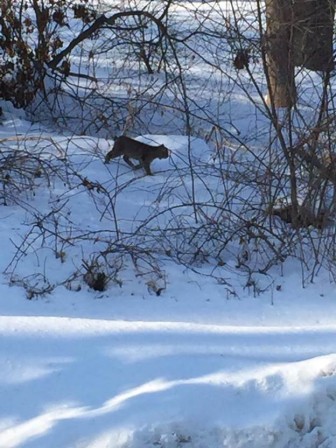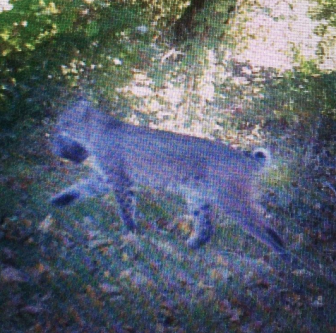A string of bobcat sightings in New Canaan has officials reopening questions about the elusive species’ prevalence in town.

This bobcat was spotted and photographed around 10 a.m. on Sunday, Dec. 20, 2015. Photo published with permission from its owner
The sighting on Monday morning of what appeared to be a perfectly healthy bobcat in a Dogwood Lane yard marked the fifth time in just three weeks that the New Canaan Police Department’s Animal Control section fielded a report that someone had seen one of the felines.
“That’s a lot of activity,” Animal Control Officer Allyson Halm said.
“They sound healthy and I’m assuming that we’re approaching the mating season, so that could be the activity. I’m also trying to understand the difference between these guys. How many do we actually think we have? What is their territory and how fast do they travel?”

Photo of a bobcat sighted in the Jelliff Mill area on the weekend of Feb. 14-15, 2015. Photo courtesy of the New Canaan Police Department’s Animal Control Unit
Officials long had believed that New Canaan had two bobcats: One that travels the Ponus Ridge corridor on the western side of town and another in the area of Gerdes Road. In September of 2014, a bobcat kitten was seen on Deep Valley Road, and Animal Control officials predicted at the time that the town would see more of them.
Last year, bobcats were spotted on Jelliff Mill and Gerdes Roads in February, Wahackme Road in April, Oenoke Ridge in October and Michigan Road in December.

This bobcat was photographed in October 2015 after tripping an outdoor camera off of Oenoke Ridge Road near Turtle Back. Published with permission of the photograph’s owner
Already in 2015, bobcat sightings have been reported on Devonwood Lane (Jan. 15), Oenoke Ridge Road (Jan. 22), Clearview Lane (Jan. 27), Laurel Road (Jan. 29) and now, Dogwood Lane (Feb. 8), according to Halm.
Connecticut’s only wild cat, bobcats breed in February and March, state officials say, and generally prey on smaller animals such as rabbits, squirrels and birds, though they may also take poultry, small pigs and sheep. Seldom seen, they’re most active after dusk and before dawn, and bobcats make dens from which they may travel up to four miles per day, according to the Connecticut Department of Energy and Environmental Protection.
They rarely cause problems for humans, the DEEP said.